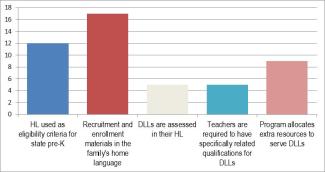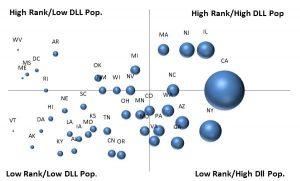
Special Report
Shortcomings of Pre-K Policies for Children Who are Dual Language Learners
November 8, 2016
The largest ethnic group among children age five and under is Hispanic, including many families whose home language is not English. How to best meet the early learning needs of these Dual Language Learners–taking into account risk factors such as poverty and limited English proficiency, as well as benefits such as a rich culture–is an important issue facing policymakers, preschool educators, and parents.
Despite findings that show how beneficial early learning experiences can be for young DLLs, only about 52 percent of Hispanic children attend center-based preschool programs, compared to 63 percent of Whites and 65 percent of African-American children. This lower rate of participation may largely be due to a lack of access to preschool, but even when DLLs do enroll, educators often do not know how to best serve them. This population’s unique characteristics and linguistic developmental trajectories demand specific practices and understanding yet teachers of DLLs are seldom trained to support these children.
The 2015 State of Preschool Yearbook released in May included a Special Report on state preschool policies designed to support DLLs. This report, the first attempt at collecting data on a national level about state policies and supports offered to our youngest DLLs and their teachers, strives to create awareness of their specific needs and inform more effective practice and policy. The report showed that supports among states are largely inconsistent and most are basic at best.
One alarming result was that only 23 of the 57 state preschool programs surveyed could report the number of 3- and 4-year-old DLLs enrolled. Without knowledge of whether programs are even serving DLLs–never mind where they are within a state–resources and supports cannot be allocated in a targeted way. Among states that can report their numbers, the number of DLLs served varies widely. For example, using census data, NIEER estimated that only 2 percent of 4-year-old DLLs are served in Missouri, compared to 62 percent in Michigan. NIEER estimates suggest that in the 31 states that reported the number of DLLs enrolled in state pre-K, 28 percent of DLLs, on average, are served.
In addition to data on the number of DLLs in state pre-K, the Yearbook Special Report also inquired about policies in place to support DLLs. Some results are presented below:

The most popular support for DLLs is having recruitment and enrollment materials translated into a child’s home language (HL). Yet with only 17 out of 57 state preschool programs using translated materials, it is not surprising that more DLLs are not enrolled in state preschool. Making recruitment materials available in the home language could help make families not only more aware of programs, but also more comfortable about enrolling their children. Lack of English proficiency has been cited in other research as a barrier for linguistically diverse families and their engagement with schools, which is also important for a child’s continued school success.
The least prevalent supports reported by states included use of assessments in DLLs’ home language and requirements for teachers to have specific certifications or qualifications for working with DLLs. Again, these results are worrisome because these supports directly affect children and their classroom learning experiences.
Assessment in the child’s home language, for example, would tell teachers–and ultimately programs–what DLL children actually understand conceptually, rather than just how proficient they are in English. Results of the assessments in English and children’s home language may look very different, and English assessments would not yield any information about what foundational skills can be enhanced in the classroom.
The small number of states reporting that teacher certifications or qualifications relating to serving DLLs are required is equally troubling, as research continuously shows that specialized knowledge for working with DLLs is key to the children’s success and to maximizing their experiences in early childhood programs.
Finally, NIEER rated states on their DLL supportive policies found on each state’s profile page. The highest ratings were reserved for states requiring teachers to have specialized certifications for teaching DLLs and at least two other supports for DLLs such as assessing children in their home languages, providing materials in the family’s home language, having additional resources allocated to serve DLLs, state Early Learning Development Standards with content to support DLLs, and state sponsored professional development focused on best practices for DLLs.
States received a mediocre rating if at least three of these supports are required but teachers were not required to have specialized training to support DLLs. Inadequate ratings were given to those programs providing less than three of the supports listed. The graphic below illustrates how states fared on the rating relative to their estimated population of DLLs.

This graphic highlights that while there is room for improvement in some states, there are also programs conscientiously working toward improvement and clearly aware of the DLL population of preschool children. For example, West Virginia reports high supports for DLLs despite its small DLL population, while New York, with a much larger population of DLLs, does not.
This Yearbook Special Report for the first time provides a systematic review of policies related to DLLs. Results showed many holes, yet these shortcomings are not insurmountable. The data also show that several states, as diverse as West Virginia, Illinois and New Jersey, are succeeding in meeting early learning needs for DLL children and their families. States that are struggling should look to those leaders for strategies to reach DLLs they aren’t serving yet, as well as better meet the needs of those already in preschool.
Dr. Figueras-Daniel is an Assistant Research Professor at the National Institute for Early Education. Her research interests include classroom practices and professional development, dual language learners and classroom practices that support dual language acquisition, and measurement of quality in multicultural contexts. She has contributed extensively to NIEER’s research on DLLs and classroom quality.
The Authors
Dr. Figueras-Daniel was awarded a Young Scholars Program grant from the Foundation for Child Development to investigate coaching and professional development of Latina preschool teachers working with DLLs. At NIEER, she leads this study as well a project to develop a Latina leadership pipeline in ECE.
About NIEER
The National Institute for Early Education Research (NIEER) at the Graduate School of Education, Rutgers University, New Brunswick, NJ, conducts and disseminates independent research and analysis to inform early childhood education policy.

